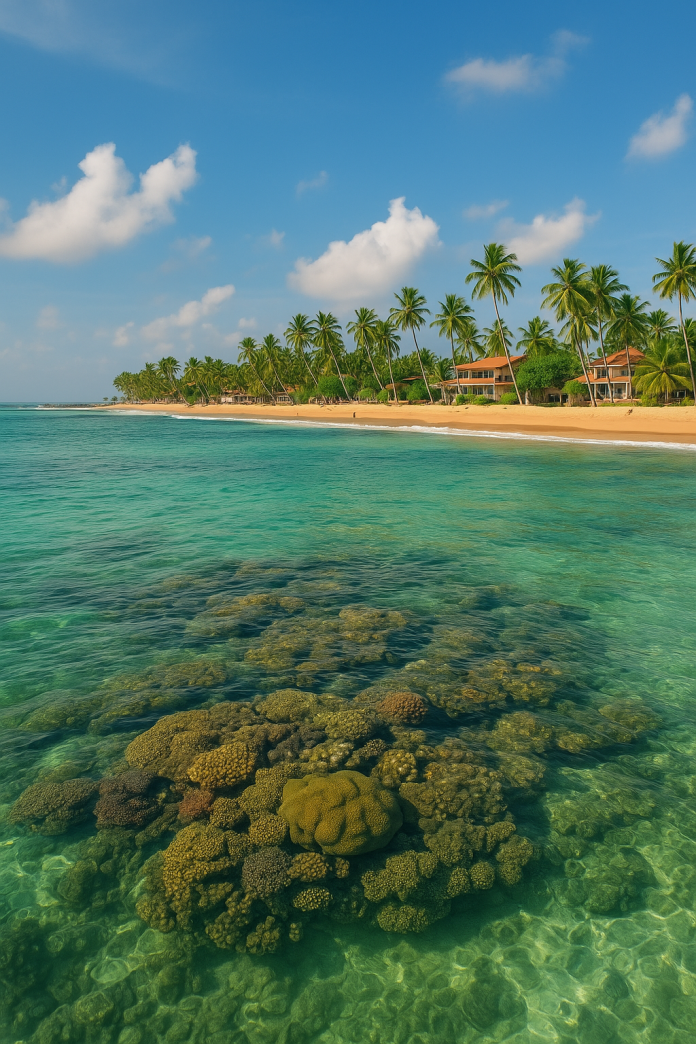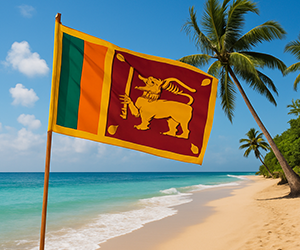Introduction: Dive into the Hidden World of Hikkaduwa’s Coral Reefs
Sri Lanka, affectionately known as the Pearl of the Indian Ocean, is renowned for its golden beaches, lush greenery, and rich biodiversity. But beneath its turquoise coastal waters lies an equally stunning and often overlooked world — its vibrant coral reefs. Nowhere is this more accessible and mesmerizing than in Hikkaduwa, a small town on the island’s southern coast.
Hikkaduwa Coral Reefs, located within the Hikkaduwa National Park, are some of the most diverse and well-preserved in Sri Lanka. These underwater gardens are home to colorful fish, sea turtles, and intricate coral structures that make the area a paradise for snorkelers, divers, and nature lovers. More than just a tourist attraction, these reefs play a vital role in marine ecology and coastal protection.
In this in-depth guide, we explore everything you need to know about coral reefs in Hikkaduwa — their beauty, importance, threats, and how you can experience them responsibly. Whether you’re planning a visit or simply curious about marine life, this article will take you on an unforgettable journey under the sea.
What Makes Coral Reefs So Special?
Coral reefs are often referred to as the “rainforests of the sea” — and for good reason. Although they occupy less than 1% of the ocean floor, coral reefs support more than 25% of all marine life.
🌊 What Are Coral Reefs?
Coral reefs are built by tiny marine animals called polyps that secrete calcium carbonate. Over thousands of years, these polyps form vast, colorful reef systems. Hikkaduwa’s reefs are fringing reefs, which means they are located close to shore and are ideal for snorkeling and shallow diving.
🌿 Why Are Coral Reefs Important?
- Biodiversity: Coral reefs support thousands of species of fish, mollusks, crustaceans, and sea turtles.
- Coastal Protection: Reefs act as natural barriers against waves, reducing coastal erosion.
- Tourism and Economy: Coral reefs attract tourists, generating income for local communities.
- Medical Discovery: Corals and marine organisms are used in developing medicines and treatments.
Hikkaduwa’s reefs offer a unique opportunity to witness this natural marvel without needing to go deep-sea diving or charter expensive boats.
The Hikkaduwa Coral Reef System
The Hikkaduwa Coral Sanctuary is part of the Hikkaduwa National Park, established in 1979 and declared a national park in 2002. It spans 101 hectares of shallow coastal waters and is one of the best places to explore marine life in Sri Lanka.
Key Features of Hikkaduwa’s Coral Reef:
- Location: Just off the shore of Hikkaduwa Beach, making it easily accessible for all visitors.
- Coral Types: Over 60 species, including brain coral, staghorn coral, table coral, and mushroom coral.
- Marine Species: The reef is home to more than 170 species of reef fish and a variety of marine invertebrates and sea turtles.
- Reef Structure: Mostly shallow, allowing sunlight to penetrate and support a thriving ecosystem.
Biodiversity: What Lives in the Coral Reefs of Hikkaduwa
Hikkaduwa’s reef system is a haven for a stunning variety of marine life. Its rich biodiversity is one of the reasons it remains a top spot for underwater exploration.
🐟 Common Fish Species:
- Parrotfish
- Butterflyfish
- Clownfish
- Angelfish
- Surgeonfish
- Groupers
🐢 Turtles and Larger Marine Animals:
- Green Sea Turtles
- Hawksbill Turtles
- Moray Eels
- Reef Sharks (rarely spotted)
🪸 Coral Species:
- Brain Coral
- Elkhorn Coral
- Table Coral
- Finger Coral
- Soft Coral varieties
This diversity makes Hikkaduwa one of the best spots in Sri Lanka for snorkeling, underwater photography, and marine research.
Best Ways to Explore the Coral Reefs in Hikkaduwa
1. Snorkeling
One of the most popular activities in Hikkaduwa, snorkeling allows visitors to explore the reef with minimal gear. The shallow reef waters are safe, warm, and crystal-clear, providing perfect visibility.
- Equipment rentals available at the beach
- Guided tours available for beginners
- Best time: November to April
2. Glass-Bottom Boat Tours
For non-swimmers or families with children, glass-bottom boats are the ideal way to explore the reef without getting wet.
- Boat tours depart from Hikkaduwa Beach
- Best during calm mornings
- Ethical operators avoid anchoring on reefs
3. Scuba Diving
Certified divers can explore the deeper parts of the reef and nearby shipwrecks.
- PADI-certified dive centers available
- Great for exploring hidden coral formations and caves
- Diving spots like “Coral Garden” and “Goda Gala Diyamba” are famous
4. Underwater Photography
The vivid colors and diverse marine life make Hikkaduwa a dream location for underwater photographers.
- Bring a waterproof camera or rent from a dive shop
- Early morning or midday offers the best light
Threats Facing Hikkaduwa’s Coral Reefs
Despite their beauty and importance, the coral reefs in Hikkaduwa face a number of serious threats:
🌡️ 1. Coral Bleaching
Climate change causes ocean temperatures to rise, stressing corals and leading to bleaching — when corals lose their color and become vulnerable to disease.
🧴 2. Pollution
Sewage discharge, sunscreen chemicals, plastic waste, and other pollutants degrade reef health.
🎣 3. Unsustainable Fishing Practices
Overfishing and illegal fishing methods such as dynamite fishing can destroy coral habitats.
🩱 4. Irresponsible Tourism
- Stepping on corals
- Touching or removing marine life
- Anchoring boats on reef structures
🌊 5. Natural Disasters
The 2004 tsunami significantly damaged parts of Hikkaduwa’s reef. While some recovery has occurred, the event highlighted the reef’s vulnerability.
Conservation Efforts in Hikkaduwa
🏞️ Hikkaduwa National Park
The reef is protected under the Department of Wildlife Conservation, which regulates tourism, fishing, and scientific research.
🤝 Community and NGO Involvement
- Local NGOs like Marine Conservation Sri Lanka work on coral restoration.
- Reef balls and coral nurseries are used to restore damaged sections.
🎓 Education and Awareness
- Awareness programs for tourists
- Eco-guides trained to educate visitors
- School programs promoting marine conservation
🌍 International Collaboration
Partnerships with organizations like IUCN and UNEP fund research and conservation programs in Hikkaduwa.
How to Visit Responsibly: Tips for Eco-Friendly Reef Exploration
As a visitor, your actions can either help or harm the coral reef ecosystem.
✅ Do:
- Use reef-safe sunscreen (free of oxybenzone and octinoxate)
- Book with certified eco-tour operators
- Respect wildlife (watch, don’t touch)
- Follow local guidelines and signage
- Support local conservation projects and businesses
❌ Don’t:
- Step on or touch coral
- Feed fish or turtles
- Take shells or coral as souvenirs
- Drop anchors near reefs
- Litter or leave waste on the beach
By being a responsible traveler, you help protect Hikkaduwa’s marine treasures for future generations.
Best Time to Visit the Coral Reefs in Hikkaduwa
The best time to visit the coral reefs is during the dry season, from November to April.
🌤️ Weather:
- Calm seas
- Excellent water clarity
- Ideal for snorkeling, diving, and boat tours
🌧️ Monsoon Season (May–October):
- Rough seas
- Reduced visibility
- Fewer tours available
For the best coral reef experience, plan your visit in the early morning when the sea is calm and the sun lights up the underwater world.
Where to Stay Near the Hikkaduwa Coral Reefs
Hikkaduwa has a range of accommodation options to suit all budgets, many within walking distance of the reef.
🏨 Beachfront Hotels:
- Coral Sands Hotel – Steps from the reef with a pool and dive center
- Hikka Tranz by Cinnamon – Popular for its location and luxury
- Riff Hikkaduwa – Modern boutique stay with eco-conscious design
🏡 Budget & Mid-Range:
- Hotel Finlanka
- Ocean View Cottage
- Blue Note Hotel
Most hotels can also assist in booking reef tours and activities.
Local Cuisine and Dining by the Reef
After a morning of snorkeling or diving, enjoy some of the best local food in beachside cafes and restaurants.
🐟 Must-Try Dishes:
- Devilled prawns
- Grilled cuttlefish
- Fish curry with coconut rice
- Kottu roti and hoppers
Popular eateries like Get Fresh Restaurant, Nordic House, and J.L.H. Beach Restaurant offer both local and international dishes.
Coral Reefs and Cultural Experiences
Combine your reef adventure with Hikkaduwa’s rich local culture.
🏯 Nearby Attractions:
- Seenigama Muhudu Viharaya – A temple on a small island
- Tsunami Museum – Commemorating the 2004 disaster
- Local Markets – Great for souvenirs and handmade crafts
Conclusion: A Natural Wonder Worth Protecting
The coral reefs in Hikkaduwa are not just beautiful — they are essential to the region’s biodiversity, economy, and cultural identity. These underwater ecosystems have survived natural disasters, climate change, and increasing tourism pressure, but they need continued protection.
As a traveler, you can experience the magic of Hikkaduwa’s coral reefs while contributing to their conservation. By choosing sustainable practices and respecting marine life, your visit can help ensure that these vibrant reefs continue to thrive.
So, pack your snorkel, head to the southern coast of Sri Lanka, and dive into a world like no other — a world where every ripple reveals a secret, and every coral tells a story.




